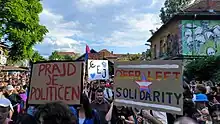.jpg.webp)
Ljubljana Pride is the annual Slovenian national LGBTIQ pride march, held in its capital of Ljubljana each June. The name also refers to the week of LGBT-related events that are held in the city prior to the march.[1] It is organized by the Pride Parade Society and strongly supported by the City of Ljubljana (a member of Rainbow Cities Network).[2][3]
History
The first pride march was organized in 2001[4] as a reaction to the impatient and insulting behavior of the staff towards Brane Mozetič and Canadian poet Jean-Paul Daoust in front of the Ljubljana City Gallery. The Pride Parade then became an annual event.
In 2009 several organizers of the event were attacked during an event at a cafe in the week prior to the march; one activist, Mitjo Blažiča, was hospitalized.[5] Amnesty International released a statement calling on Slovenian authorities to condemn the incident and ensure that the Pride event could go on safely.[6]
As of 2010, the event had not needed to deal with large numbers of counter protesters.[7]

The most recent Ljubljana Pride, on June 17, 2023, attracted a crowd of 3,500 according to organizers. This was also the first time the event was addressed by the current head of state; president Nataša Pirc Musar described it as “an expression of the fight for human dignity. It is a protest with the clear message that every human being, regardless of their sexual orientation, sexual identity or sexual expression is worthy of respect, love and equal treatment”.[8] Labour Minister Luka Mesec, and Minister for a Solidarity-Based Future Simon Maljevac, Slovenia's first openly gay member of government, also attended.[9] During and after the parade, attendees faced threats, violence, insults, flag burnings, and destruction of private property. A Katja Sešek, a representative of the Pride Parade Association, told Radio Slovenia that there had not been such hostility for years. Mitja Blažič, a long-time activist and previous victim of similar attacks, highlighted the multiple instances of violence, homophobia, and transphobia during the Pride Parade as unprecedented and unsettling.[10]
See also
References
- ↑ Baker, Mark; Ham, Anthony; Lee, Jessica (2019). Lonely Planet Slovenia. ISBN 9781788685771.
- ↑ "History". Društvo Parada Ponosa. Archived from the original on 2023-06-21. Retrieved 2023-06-21.
- ↑ "LGBT friendly". www.ljubljana.si. Archived from the original on 2023-06-22. Retrieved 2023-06-22.
- ↑ "Pride around the world: Celebration and protest in 2017". CBC News. June 24, 2017. Archived from the original on 29 December 2023. Retrieved 22 June 2023.
- ↑ B, M. R. , T. K. "Foto: Brutalen napad v Ljubljani". rtvslo.si (in Slovenian). Archived from the original on 2023-08-11. Retrieved 2023-06-22.
{{cite web}}: CS1 maint: multiple names: authors list (link) - ↑ "Slovenia: Violence surrounds the Ljubljana Pride" (PDF). amnesty.org. 26 June 2009. Archived (PDF) from the original on 22 June 2023. Retrieved 22 June 2023.
- ↑ Ayoub, Phillip M. (May 3, 2016). When States Come Out. Cambridge University Press. p. 158. ISBN 9781316790779.
- ↑ N. Š. (17 June 2023). "To se je v Ljubljani dogajalo na dan Parade ponosa" [What Happened in Ljubljana on the Day of the Pride Parade] (in Slovenian). Žurnal24.si. Archived from the original on 22 June 2023. Retrieved 22 June 2023.
- ↑ "Pride Parade highlights need for continued fight". Slovenia Times. 2023-06-17. Archived from the original on 2023-06-22. Retrieved 2023-06-22.
- ↑ Dr. Boris Vezjak (June 19, 2023). "»Samo dva spola« / Nasilje in nestrpnost na Paradi ponosa" ["Only Two Genders" / Violence and Intolerance at the Pride Parade]. Mladina. Archived from the original on 2023-06-20. Retrieved 2023-06-19.